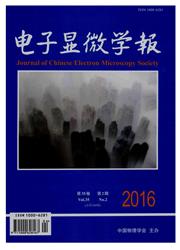

 中文摘要:
中文摘要:
应用扫描电子显微镜对8个不同品种的水稻(Oryza sativa L.)叶片表面硅质细胞的形态结构进行了观察,并首次用X射线能谱分析其硅含量.结果发现8个品种间叶片表面硅质细胞形态结构和硅元素含量差异明显,四倍体品种不但硅质细胞大,而且硅元素含量也较高,其中矮脚南特-4x叶片表面硅质细胞表面积最大,达301.40mm^2,硅元素相对含量也最高,为32.77 wt.%;广陆矮4号-4x硅质细胞表面积次之,为192.50mm^2,硅元素相对含量为25.80 wt.%.这2个四倍体品种的气孔硅乳突数都是8个,比二倍体品种多1倍.四倍体品种田间表现植株直立、基部通风性好、抗倒伏能力和抗病虫性均较强.二倍体品种零轮、P23、L202、D27 F2(野生稻杂种)、华粳籼74和E5等品种硅质细胞表面积明显比四倍体的小,平均小3.6倍;硅元素含量也较低,平均比四倍体的低1.4倍;抗性较2个四倍体水稻品种差.本文的结果初步说明水稻叶片硅质细胞大小和含量与抗性可能存在密切的相关.
 英文摘要:
英文摘要:
The morphology of silicon cells on leave surface in eight varieties of rice was observed by using scanning electron microscopy, and the content of silicon was detected by using energy dispersive X-ray spectrum. The results showed that there existed differences in the morphology of silicon cells and content of silicon among different varieties. Furthermore, high number and larger volume of silicon cells and higher content of silicon were found on the blade surface of the autotetraploid varieties than those in the diploid varieties. Among the autotetraploid rices, Aijiaonante-4x was the largest in the silicon cell with 301.40μm^2 , and the highest in the content of silicon with 32.77 wt. % ; Guanglu'No.4 was the second in the silicon cell with 192.50μm^2 as well as in the content of silicon with 25.80 wt. %. There were eight pieces of silicon papilla in the two autotetraploid rices, which was twice as that in the diploid rice. These two autotetraploid varieties possessed straighter stems, better ventilation under leaves, higher lodging-resistance and insect-resistance in comparison with the varieties with smaller volume of silicon cells and lower content of silicon, such as Linglun, P23, 1202, D27F2, Huajingxian No .74 and E5 which was not as good in these aspects. The results here indicated that the size and the content of silicon were associated with the lodging-resistance and insect-resistance and it may be considered as an important qualification for future breeding.
 同期刊论文项目
同期刊论文项目
 同项目期刊论文
同项目期刊论文
 期刊信息
期刊信息
